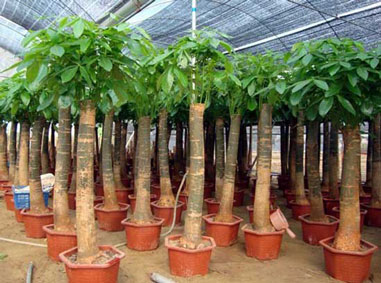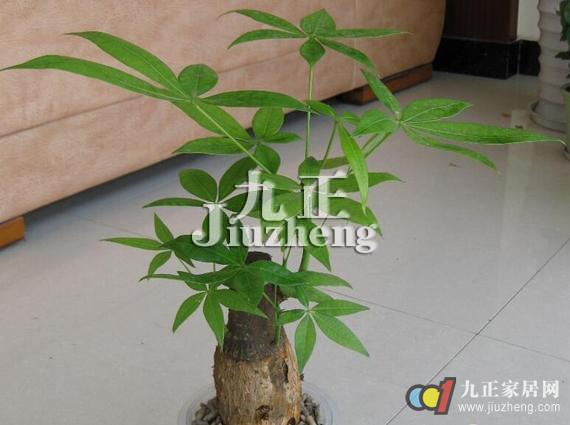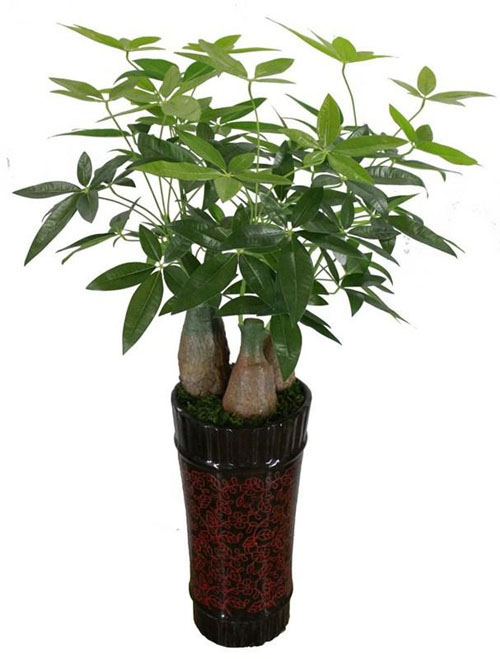How to breed and cultivate rich trees?
The rich tree is a very popular indoor potted foliage and stem plant in China in the 1990s, and it is also one of the trendy foliage flowers. It is very suitable for ornamental and decorative plant cultivation in offices, halls and other places.
The rich tree can be propagated by both cutting method and sowing method. The rich tree propagated with seeds has large stem base and high ornamental value, while the stem propagated by cutting method has no hypertrophy at the base and low ornamental value. Therefore, the method of sowing is often used to propagate.
When sowing, the ripe fresh seeds can be inserted into the basin of plain sand or vermiculite to keep the substrate moist properly and germinate after about 10 days. The seedlings were transplanted when they had 3-5 young leaves. When planting, it is appropriate to plant shallowly to expose the inflated roots. As the rich tree is taller after its complete plant shape, in order to promote its root system to develop well, large deep tube flowerpots should be selected when planting. The basin soil was prepared with 4 parts of leaf soil (or peat soil) rich in humus, 4 parts of garden soil and 2 parts of river sand. In order to make the basin soil nutritious, another 50 grams of 100 grams of bone meal or rotten cake residue can be added as base fertilizer. (culture methods and matters needing attention of rich trees)
The rich tree likes the humid environment, so it is advisable to keep the basin soil moist during the growth period to avoid being too dry or too wet. If too much watering, the root is easy to rot, resulting in yellow leaves, affecting the outlook. If long-term stagnant water, it is very easy to lead to plant death. It can thrive by applying thin pancake fertilizer and water once a month in spring, summer and autumn. When fertilizing, pay attention to put more phosphorus and potassium fertilizer is conducive to the base of the stem hypertrophy, show the beauty of vitality and simplicity, and improve the ornamental value.
The rich tree is light-loving and shade-tolerant, and its leaves can be kept tender and green when placed indoors under bright scattered light. Avoid direct light in summer, otherwise the leaves and tips are easy to scorch, and the color of the leaves is also easy to fade. In order to keep the leaf color green, water should be sprayed on the leaf surface once or twice every morning and evening in summer to improve air humidity.
The rich tree likes warmth and is not cold-resistant, and the winter room temperature should be kept above 10 ℃. If it is less than 8 ℃, it is easy to cause cold injury, cause fallen leaves, and even die. The rich tree is resistant to pruning, so it should be pruned in time in spring to renew its branches and leaves. If there are few branches, the heart can be extracted, and new branches can germinate below the shearing mouth, so that the number of branches can be increased, and the plant shape will be more plump, which also provides conditions for binding modeling. Generally, the basin should be changed once every 1-2 years in early spring, and the diameter of the basin should be increased year by year, and the withered roots should be trimmed, the base fertilizer should be increased and the culture soil should be renewed to facilitate growth.
Introduction to Propagation methods and cultivation techniques of Rich Tree

- Prev

How do rich trees reproduce?
The rich tree, also known as Malabasu, is a small tropical evergreen tree of the kapok family, native to Central America and Mexico. Sex likes warmth, the original fruit tree is cultivated, but the blossom and fruit is unstable, it is mainly used as green ornamental plant in our country, sunny, drought-tolerant. Its shade tolerance is also very strong, so it is a good indoor ornamental plant. The plant has strong plasticity.
- Next

The method of potted culture of rich trees
P.aquaticaAubl, due to its English name Malabarchestnut and transliteration of Malaba chestnut, belongs to the kapok family perennial evergreen trees, native to Mexico, Venezuela and other places, with erect trunk, whorled branches and palmately compound leaves.
Related
- Fuxing push coffee new agricultural production and marketing class: lack of small-scale processing plants
- Jujube rice field leisure farm deep ploughing Yilan for five years to create a space for organic food and play
- Nongyu Farm-A trial of organic papaya for brave women with advanced technology
- Four points for attention in the prevention and control of diseases and insect pests of edible fungi
- How to add nutrient solution to Edible Fungi
- Is there any good way to control edible fungus mites?
- Open Inoculation Technology of Edible Fungi
- Is there any clever way to use fertilizer for edible fungus in winter?
- What agents are used to kill the pathogens of edible fungi in the mushroom shed?
- Rapid drying of Edible Fungi

